Gül Varol
Dense Motion Captioning
Nov 07, 2025Abstract:Recent advances in 3D human motion and language integration have primarily focused on text-to-motion generation, leaving the task of motion understanding relatively unexplored. We introduce Dense Motion Captioning, a novel task that aims to temporally localize and caption actions within 3D human motion sequences. Current datasets fall short in providing detailed temporal annotations and predominantly consist of short sequences featuring few actions. To overcome these limitations, we present the Complex Motion Dataset (CompMo), the first large-scale dataset featuring richly annotated, complex motion sequences with precise temporal boundaries. Built through a carefully designed data generation pipeline, CompMo includes 60,000 motion sequences, each composed of multiple actions ranging from at least two to ten, accurately annotated with their temporal extents. We further present DEMO, a model that integrates a large language model with a simple motion adapter, trained to generate dense, temporally grounded captions. Our experiments show that DEMO substantially outperforms existing methods on CompMo as well as on adapted benchmarks, establishing a robust baseline for future research in 3D motion understanding and captioning.
Shot-by-Shot: Film-Grammar-Aware Training-Free Audio Description Generation
Apr 01, 2025Abstract:Our objective is the automatic generation of Audio Descriptions (ADs) for edited video material, such as movies and TV series. To achieve this, we propose a two-stage framework that leverages "shots" as the fundamental units of video understanding. This includes extending temporal context to neighbouring shots and incorporating film grammar devices, such as shot scales and thread structures, to guide AD generation. Our method is compatible with both open-source and proprietary Visual-Language Models (VLMs), integrating expert knowledge from add-on modules without requiring additional training of the VLMs. We achieve state-of-the-art performance among all prior training-free approaches and even surpass fine-tuned methods on several benchmarks. To evaluate the quality of predicted ADs, we introduce a new evaluation measure -- an action score -- specifically targeted to assessing this important aspect of AD. Additionally, we propose a novel evaluation protocol that treats automatic frameworks as AD generation assistants and asks them to generate multiple candidate ADs for selection.
Chapter-Llama: Efficient Chaptering in Hour-Long Videos with LLMs
Mar 31, 2025Abstract:We address the task of video chaptering, i.e., partitioning a long video timeline into semantic units and generating corresponding chapter titles. While relatively underexplored, automatic chaptering has the potential to enable efficient navigation and content retrieval in long-form videos. In this paper, we achieve strong chaptering performance on hour-long videos by efficiently addressing the problem in the text domain with our 'Chapter-Llama' framework. Specifically, we leverage a pretrained large language model (LLM) with large context window, and feed as input (i) speech transcripts and (ii) captions describing video frames, along with their respective timestamps. Given the inefficiency of exhaustively captioning all frames, we propose a lightweight speech-guided frame selection strategy based on speech transcript content, and experimentally demonstrate remarkable advantages. We train the LLM to output timestamps for the chapter boundaries, as well as free-form chapter titles. This simple yet powerful approach scales to processing one-hour long videos in a single forward pass. Our results demonstrate substantial improvements (e.g., 45.3 vs 26.7 F1 score) over the state of the art on the recent VidChapters-7M benchmark. To promote further research, we release our code and models at our project page.
Lost in Translation, Found in Context: Sign Language Translation with Contextual Cues
Jan 16, 2025



Abstract:Our objective is to translate continuous sign language into spoken language text. Inspired by the way human interpreters rely on context for accurate translation, we incorporate additional contextual cues together with the signing video, into a new translation framework. Specifically, besides visual sign recognition features that encode the input video, we integrate complementary textual information from (i) captions describing the background show, (ii) translation of previous sentences, as well as (iii) pseudo-glosses transcribing the signing. These are automatically extracted and inputted along with the visual features to a pre-trained large language model (LLM), which we fine-tune to generate spoken language translations in text form. Through extensive ablation studies, we show the positive contribution of each input cue to the translation performance. We train and evaluate our approach on BOBSL -- the largest British Sign Language dataset currently available. We show that our contextual approach significantly enhances the quality of the translations compared to previously reported results on BOBSL, and also to state-of-the-art methods that we implement as baselines. Furthermore, we demonstrate the generality of our approach by applying it also to How2Sign, an American Sign Language dataset, and achieve competitive results.
MotionFix: Text-Driven 3D Human Motion Editing
Aug 01, 2024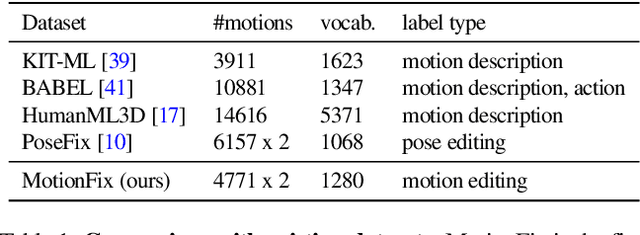


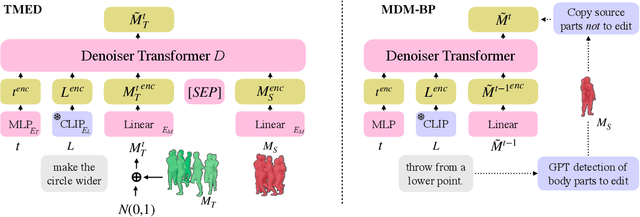
Abstract:The focus of this paper is 3D motion editing. Given a 3D human motion and a textual description of the desired modification, our goal is to generate an edited motion as described by the text. The challenges include the lack of training data and the design of a model that faithfully edits the source motion. In this paper, we address both these challenges. We build a methodology to semi-automatically collect a dataset of triplets in the form of (i) a source motion, (ii) a target motion, and (iii) an edit text, and create the new MotionFix dataset. Having access to such data allows us to train a conditional diffusion model, TMED, that takes both the source motion and the edit text as input. We further build various baselines trained only on text-motion pairs datasets, and show superior performance of our model trained on triplets. We introduce new retrieval-based metrics for motion editing and establish a new benchmark on the evaluation set of MotionFix. Our results are encouraging, paving the way for further research on finegrained motion generation. Code and models will be made publicly available.
AutoAD-Zero: A Training-Free Framework for Zero-Shot Audio Description
Jul 22, 2024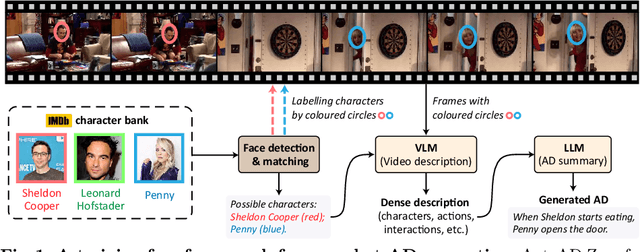

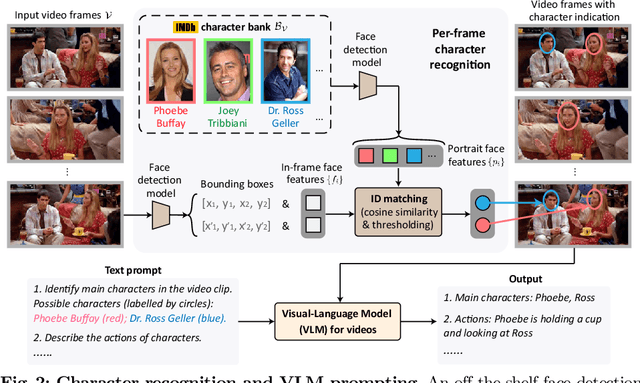

Abstract:Our objective is to generate Audio Descriptions (ADs) for both movies and TV series in a training-free manner. We use the power of off-the-shelf Visual-Language Models (VLMs) and Large Language Models (LLMs), and develop visual and text prompting strategies for this task. Our contributions are three-fold: (i) We demonstrate that a VLM can successfully name and refer to characters if directly prompted with character information through visual indications without requiring any fine-tuning; (ii) A two-stage process is developed to generate ADs, with the first stage asking the VLM to comprehensively describe the video, followed by a second stage utilising a LLM to summarise dense textual information into one succinct AD sentence; (iii) A new dataset for TV audio description is formulated. Our approach, named AutoAD-Zero, demonstrates outstanding performance (even competitive with some models fine-tuned on ground truth ADs) in AD generation for both movies and TV series, achieving state-of-the-art CRITIC scores.
A Cross-Dataset Study for Text-based 3D Human Motion Retrieval
May 27, 2024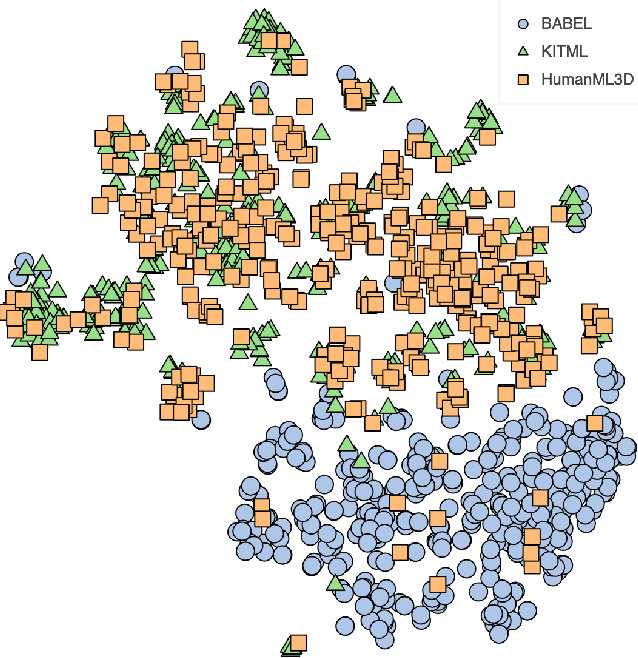
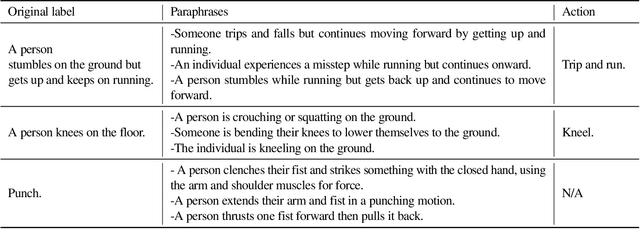


Abstract:We provide results of our study on text-based 3D human motion retrieval and particularly focus on cross-dataset generalization. Due to practical reasons such as dataset-specific human body representations, existing works typically benchmarkby training and testing on partitions from the same dataset. Here, we employ a unified SMPL body format for all datasets, which allows us to perform training on one dataset, testing on the other, as well as training on a combination of datasets. Our results suggest that there exist dataset biases in standard text-motion benchmarks such as HumanML3D, KIT Motion-Language, and BABEL. We show that text augmentations help close the domain gap to some extent, but the gap remains. We further provide the first zero-shot action recognition results on BABEL, without using categorical action labels during training, opening up a new avenue for future research.
A Tale of Two Languages: Large-Vocabulary Continuous Sign Language Recognition from Spoken Language Supervision
May 16, 2024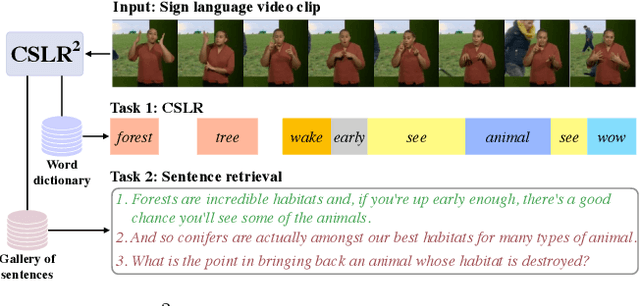

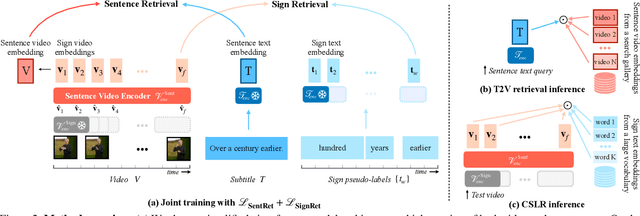

Abstract:In this work, our goals are two fold: large-vocabulary continuous sign language recognition (CSLR), and sign language retrieval. To this end, we introduce a multi-task Transformer model, CSLR2, that is able to ingest a signing sequence and output in a joint embedding space between signed language and spoken language text. To enable CSLR evaluation in the large-vocabulary setting, we introduce new dataset annotations that have been manually collected. These provide continuous sign-level annotations for six hours of test videos, and will be made publicly available. We demonstrate that by a careful choice of loss functions, training the model for both the CSLR and retrieval tasks is mutually beneficial in terms of performance -- retrieval improves CSLR performance by providing context, while CSLR improves retrieval with more fine-grained supervision. We further show the benefits of leveraging weak and noisy supervision from large-vocabulary datasets such as BOBSL, namely sign-level pseudo-labels, and English subtitles. Our model significantly outperforms the previous state of the art on both tasks.
Learning text-to-video retrieval from image captioning
Apr 26, 2024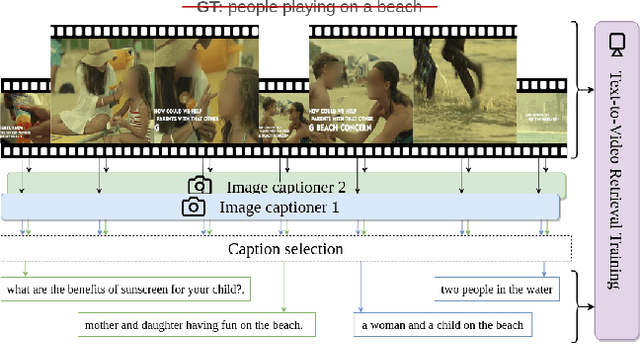
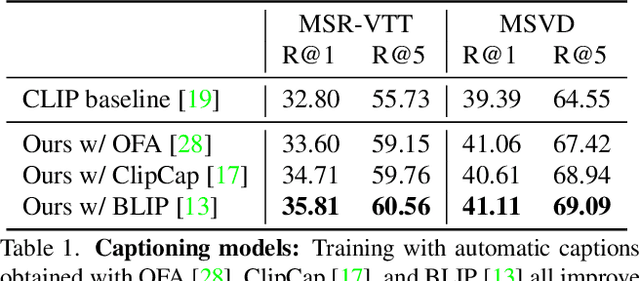

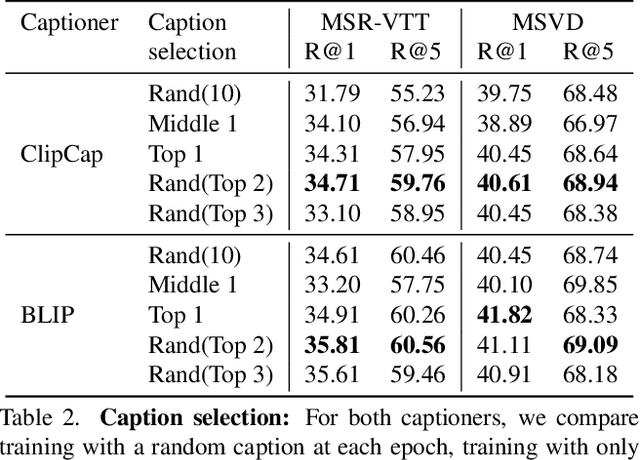
Abstract:We describe a protocol to study text-to-video retrieval training with unlabeled videos, where we assume (i) no access to labels for any videos, i.e., no access to the set of ground-truth captions, but (ii) access to labeled images in the form of text. Using image expert models is a realistic scenario given that annotating images is cheaper therefore scalable, in contrast to expensive video labeling schemes. Recently, zero-shot image experts such as CLIP have established a new strong baseline for video understanding tasks. In this paper, we make use of this progress and instantiate the image experts from two types of models: a text-to-image retrieval model to provide an initial backbone, and image captioning models to provide supervision signal into unlabeled videos. We show that automatically labeling video frames with image captioning allows text-to-video retrieval training. This process adapts the features to the target domain at no manual annotation cost, consequently outperforming the strong zero-shot CLIP baseline. During training, we sample captions from multiple video frames that best match the visual content, and perform a temporal pooling over frame representations by scoring frames according to their relevance to each caption. We conduct extensive ablations to provide insights and demonstrate the effectiveness of this simple framework by outperforming the CLIP zero-shot baselines on text-to-video retrieval on three standard datasets, namely ActivityNet, MSR-VTT, and MSVD.
AutoAD III: The Prequel -- Back to the Pixels
Apr 22, 2024Abstract:Generating Audio Description (AD) for movies is a challenging task that requires fine-grained visual understanding and an awareness of the characters and their names. Currently, visual language models for AD generation are limited by a lack of suitable training data, and also their evaluation is hampered by using performance measures not specialized to the AD domain. In this paper, we make three contributions: (i) We propose two approaches for constructing AD datasets with aligned video data, and build training and evaluation datasets using these. These datasets will be publicly released; (ii) We develop a Q-former-based architecture which ingests raw video and generates AD, using frozen pre-trained visual encoders and large language models; and (iii) We provide new evaluation metrics to benchmark AD quality that are well-matched to human performance. Taken together, we improve the state of the art on AD generation.
 Add to Chrome
Add to Chrome Add to Firefox
Add to Firefox Add to Edge
Add to Edge